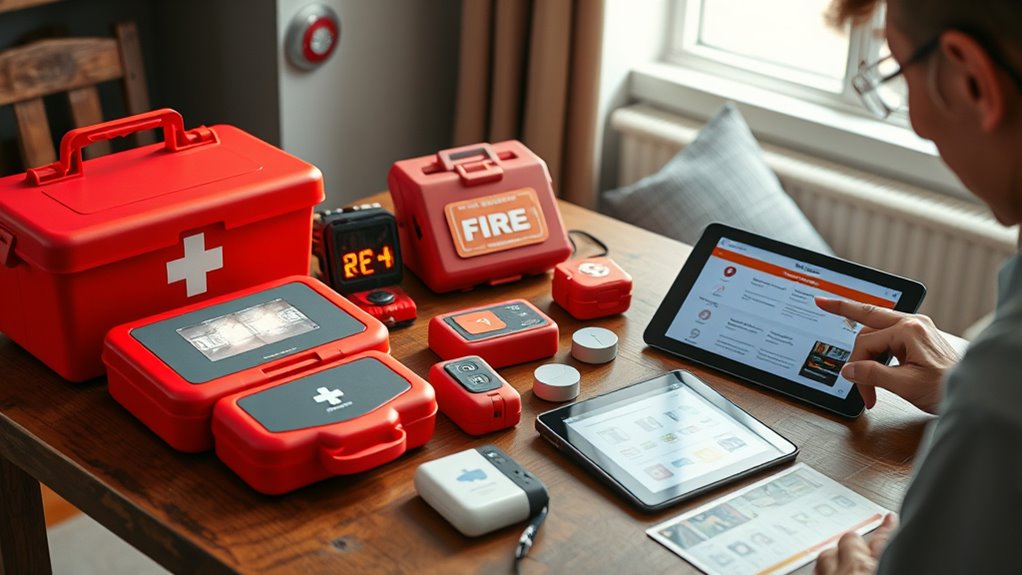To prepare for emergencies with hearing loss, set up visual alert systems like flashing lights and vibrating alarms, and identify your nearest visual cues and exits. Establish a support network of friends or neighbors who can help during crises, and keep communication cards ready to explain your needs. Practice your evacuation plans regularly and maintain your safety devices. By combining technology, planning, and support, you’ll be better equipped—keep exploring for more tips to stay safe.
Key Takeaways
- Install visual and vibrating alert systems in key areas to ensure immediate awareness of emergencies.
- Develop an emergency plan that includes visual cues, practiced evacuation routes, and accessible communication methods.
- Establish support networks with friends, family, or neighbors for timely alerts and assistance.
- Regularly test and maintain assistive devices, such as visual alarms and alert systems, to ensure functionality.
- Educate yourself and others about effective communication strategies and available technology options for emergencies.

Living with hearing loss means you need to take extra steps to stay safe during emergencies. Your ability to hear alarms, sirens, or warnings might be limited, so planning ahead is essential. One of the most effective ways to improve your safety is by using assistive technology. Devices like vibrating alarm clocks, flashing light alerts, or visual notification systems can signal you when there’s an emergency. These tools ensure you’re promptly aware of danger, even if you can’t hear traditional alarms. It’s also smart to incorporate communication strategies that work best for you. This might mean establishing a network of friends, family, or neighbors who can alert you to emergencies or check on you if something happens. You could also carry a portable alert device that syncs with your smartphone or wearable tech, allowing you to receive alerts directly on your devices.
Creating a personalized emergency plan is critical. Know the locations of the nearest emergency exits with visual cues, and practice evacuating using these routes. Make sure your home has visual alarms installed in key areas like bedrooms, living rooms, and bathrooms. These alarms can be connected to your existing alert systems to provide a clear, visual warning when needed. Keep a dedicated emergency kit in an accessible spot, stocked with essentials like batteries, a flashlight, and a charged phone with your emergency contacts saved. It’s also helpful to have a written or visual communication card that clearly states your hearing loss and preferred ways to communicate, which you can show to emergency responders or bystanders. Additionally, understanding how contrast ratio affects the clarity and visibility of visual alarms can help you select the most effective alert devices for your environment.
Practicing your emergency plan regularly will boost your confidence and ensure everything runs smoothly when it’s needed most. During drills, test your assistive technology and visual alarms to confirm they work correctly. Make adjustments as needed, and always keep backup batteries or devices on hand. Educate those around you about your hearing loss and the specific communication strategies that help you understand and respond during a crisis. This way, they can assist effectively if you’re unable to communicate verbally. By combining assistive technology with clear communication strategies and thorough planning, you make your environment safer and more responsive to your needs. Staying prepared not only minimizes risks but also empowers you to respond quickly and confidently in emergencies.
Frequently Asked Questions
How Can I Alert Neighbors During an Emergency if I Have Hearing Loss?
You can alert neighbors during an emergency by using visual signaling and alert systems. Install flashing light alarms or strobe lights that activate during emergencies, ensuring they’re visible from a distance. You can also place visual alerts outside your home, like signs indicating your hearing loss. Inform neighbors about your alert system, so they know to check on you if they see flashing lights or hear alarms, enhancing your safety.
What Specific Technology Options Are Best for Emergency Alerts for Hearing-Impaired Individuals?
You should consider visual alerts like strobe lights and vibrating alerts such as bed shakers or wearable devices. These technologies provide immediate notifications during emergencies, ensuring you don’t miss critical alerts. Combining visual and vibrating alerts maximizes safety, especially if you’re in noisy environments or asleep. Choose devices compatible with your home setup and consider smartphone apps that send visual or vibrating notifications during emergencies for added security.
How Do I Ensure My Emergency Plan Accommodates My Hearing Devices?
You guarantee your emergency plan accommodates your hearing devices by including sign language communication options and maintaining your devices’ batteries. Keep emergency kit essentials like extra hearing aid batteries, a visual alert system, and a written emergency plan. Practice using sign language with loved ones, and update your plan regularly to include new tools or strategies. This way, you’re prepared to stay informed and connected during any emergency.
Are There Community Resources Available for Deaf or Hard-Of-Hearing Emergency Preparedness?
Yes, community outreach programs and resource directories can help you access emergency preparedness support for deaf or hard-of-hearing individuals. Local organizations often offer training, communication tools, and alerts tailored to your needs. You should check with your community’s resource directories or contact local agencies specializing in disability services. These resources connect you with essential information, support networks, and technology to keep you safe during emergencies.
How Can I Practice Emergency Drills Effectively With My Hearing Loss?
Think of your emergency drills as rehearsals for a life-saving performance. You can practice effectively by incorporating sign language training to communicate clearly during emergencies. Customize your emergency kit with visual alerts and assistive devices, ensuring they’re within reach. Regularly simulate scenarios, using visual cues and written instructions, so you’re prepared when seconds count. This proactive approach turns chaos into calm, empowering you to respond confidently and swiftly.
Conclusion
Don’t let hearing loss hold you back from being prepared. You might think emergencies are only for others, but everyone benefits from a plan. Using visual alerts and having a clear communication plan can make all the difference. Remember, being proactive keeps you safe and confident. So, take those extra steps now—your safety and peace of mind are worth it. You’ve got this, and help is always within reach.










